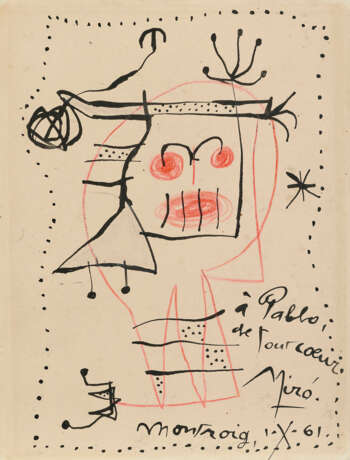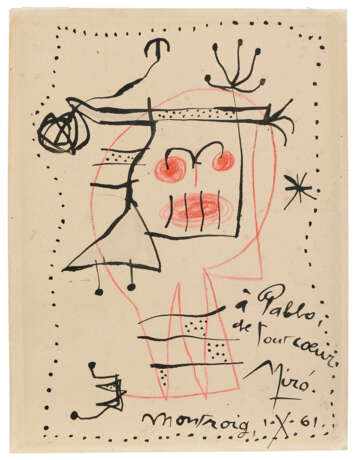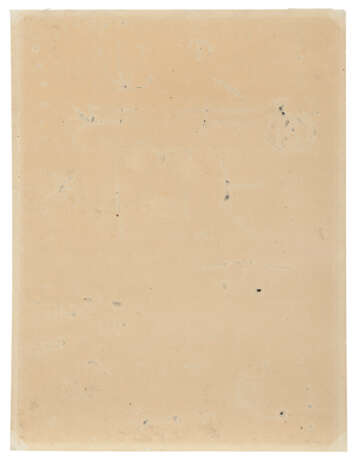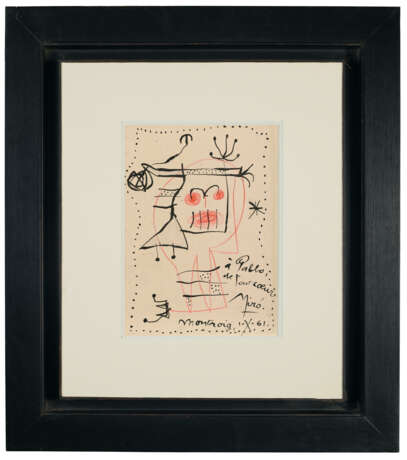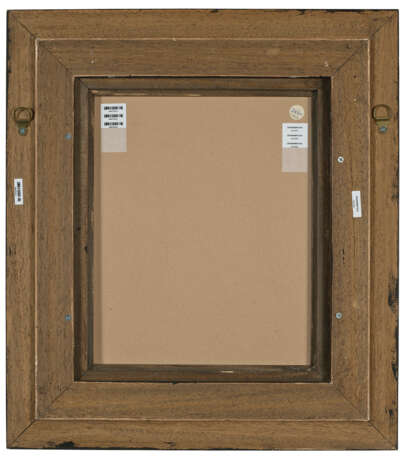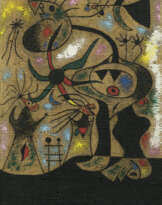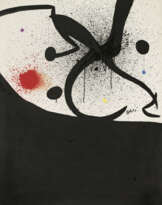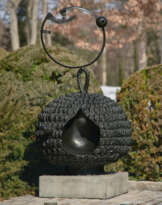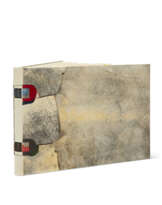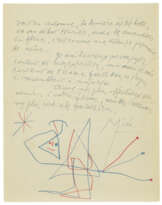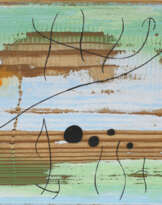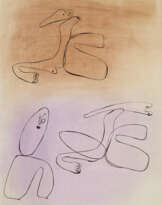ID 929403
Лот 12 | Joan Miró (1893-1983)
Оценочная стоимость
€ 30 000 – 50 000
Sans titre
signé, daté et inscrit ‘à Pablo de tout cœur. Miró. montroig I-X-61.’ (en bas à droite)
encre de Chine et crayon de couleur sur papier
27 x 20.7 cm.
Exécuté à Mont-roig del Camp le 1er octobre 1961
signed, dated and inscribed ‘à Pablo de tout cœur. Miró. montroig I-X-61.’ (lower right)
brush and India ink and coloured crayon on paper
10 5/8 x 8 1/8 in.
Executed in Mont-roig del Camp on 1st October 1961
Provenance
Pablo Picasso, France (don de l'artiste en 1961).
Georges Tabaraud, France (don de celui-ci).
Don de celui-ci au propriétaire actuel.
Literature
G. Tabaraud, 'Au petit jeu de l'anniversaire', in Le Patriote de Nice et du sud-est, Nume´ro spe´cial, À tes 20 ans, Pablo !, 25 octobre 1961, p. 3 (illustré en couleurs).
Special notice
Artist's Resale Right ("droit de Suite").
If the Artist's Resale Right Regulations 2006 apply to this lot, the buyer also agrees to pay us an amount equal to the resale royalty provided for in those Regulations, and we undertake to the buyer to pay such amount to the artist's collection agent.
Post lot text
En octobre 1961, Georges Tabaraud sollicite un certain nombre d’amis de Picasso pour participer à un numéro spécial du journal "Le Patriote de Nice", édité à l’occasion du 80ème anniversaire de l’artiste. C’est dans le cadre de cette publication que Miró réalise le présent dessin, qu’il dédicace et offert à Picasso, pour qu’il soit reproduit dans ce numéro spécial, paru le 25 octobre 1961, jour de l’anniversaire de l’artiste.
Léger, Braque, Le Corbusier, Cocteau, Alberti, Kahnweiler, Zervos, Cassou, Prévert, Hugnet, Sabartes, Duncan, et tant d’autres, ont également collaboré à ce numéro. Pour remercier Georges Tabaraud de cette intention, Picasso lui a par la suite offert le présent dessin.
Pablo Picasso et Joan Miró se sont rencontrés à Paris en 1920, lorsque le jeune Miró est venu visiter l'atelier de Picasso rue La Boétie. Malgré leurs personnalités différentes, une amitié est née, qui durera jusqu'à la mort de Pablo. Selon les mots de Joan Punyet, petit-fils de Miró, "les liens qui les unissaient allaient bien au-delà de ce qu'ils pouvaient simplement apparaître. L'aspect humain était capital, en maintenant un engagement politique, social et culturel qui les a toujours accompagnés". L'admiration de Miró pour son "mentor" est évidente puisque, lorsqu'on lui a demandé qui étaient les trois peintres les plus importants du XXe siècle, il a répondu : en premier Picasso, en deuxième Picasso, en troisième Picasso.
Journaliste avant-guerre dans la presse parisienne, Georges Tabaraud participe au combat de la Résistance avant de devenir, peu après la Libération, le rédacteur en chef du "Patriote de Nice et du Sud-Est", puis son directeur jusqu’en 1977. « Pendant ces trente-trois années, j’ai aimé ce métier avec ses jours de gloire, ses jours de colère, ses échecs et ses réussites, ses grandes illusions et ses immenses joies, » écrit-il dans son papier intitulé "Souvenirs des bonnes années", et d’ajouter aussitôt: « je dois au journal ma rencontre avec Picasso. Elle illuminera ma vie. »
Georges et Pablo, c’est l’histoire incroyable d’un jeune journaliste tout juste sorti des maquis FTP, seul disponible à la rédaction en cette journée ensoleillée d’août 1946, pour aller à la rencontre, sur une plage de Golfe-Juan, du génie espagnol qui venait, après son adhésion au PCF, de s’installer sur la Côte d’Azur en compagnie de l’éblouissante Françoise Gilot. « pour moi, cette journée avait été extraordinaire, pleine de joie et d’admiration ; j’avais trouvé chez cet homme dont j’avais tant craint la rencontre, une fraternité, une gentillesse, une chaleur que jamais je n’aurais pu envisager. Je pensais en le quittant que jamais je n’oserai revenir, » raconte-t-il dans un étonnant livre de souvenirs sur cette profonde amitié qui se noua entre eux, sans doute dès ce premier contact (G. Tabaraud, Mes années Picasso, Paris, 2001).
Dès lors, Georges Tabaraud fut le grand témoin du dernier tiers, particulièrement mouvementé, de la vie de Pablo Picasso. Des fêtes données en son honneur à Vallauris en compagnie d’Aragon, de Cocteau, de Prévert, de son militantisme en faveur de la paix avec notamment la création de la fameuse Colombe, mais aussi des crises avec le PCF, par exemple lors de l’affaire du portrait de Staline et des drames, plus intimes, de la séparation avec Françoise.
Le "Patriote" étant devenu le journal de Picasso, notamment à l’occasion de chaque carnaval de Nice, le journaliste a également suivi de près cette période "vallaurienne" et "antiboise" particulièrement féconde durant laquelle le peintre découvrit les perspectives créatrices offertes par la linogravure et la céramique et réalisa sa célèbre fresque sur panneaux "La Guerre et la Paix".
In October 1961, Georges Tabaraud solicited several friends of Picasso to participate in a special issue of the newspaper "Le Patriote de Nice", published on the occasion of the artist's 80th birthday. Miró made this drawing, which he dedicated and offered to Picasso, to be reproduced in this special issue, which appeared on October 25, 1961, the artist's birthday. Léger, Braque, Le Corbusier, Cocteau, Alberti, Kahnweiler, Zervos, Cassou, Prévert, Hugnet, Sabartes, Duncan, and so many others, also contributed to this issue. To thank Georges Tabaraud for this intention, Picasso later gave him this drawing. Pablo Picasso and Joan Miró met in Paris in 1920, when a young Miró came to visit Picasso's studio on rue La Boétie. Despite their different personalities, a friendship was born then, which will last until Pablo's death. According to what Joan Punyet, grandson of Miró, said "the bonds between them went far beyond what they could just appear. The human aspect was capital, maintaining a political, social and cultural commitment which has always accompanied them ". Miró's admiration for his "mentor" is evident since, when asked who were the three most important painters of the twentieth century, he replied: first Picasso, second Picasso, third Picasso.
Journalist before the war in the Parisian press, Georges Tabaraud took part in the fight for the Resistance before becoming, shortly after the Liberation, the editor-in-chief of the "Patriote de Nice et du Sud-Est", then its director until 1977. "During these thirty-three years, I have loved this profession with its glory days, its days of anger, its failures and its successes, its great illusions and its immense joys," he writes in his paper entitled "Souvenirs des bonnes années", and immediately adds: "I owe my meeting with Picasso to the diary. It will light up my life. "
Georges and Pablo, this is the incredible story of a young journalist who has just left the FTP maquis, the only one available to the editorial staff on that sunny day in August 1946, on this sunny day in August 1946, to meet, on a beach in Golfe-Juan, the Spanish genius who had just, after joining the PCF, settled on the Côte d'Azur in the company of the dazzling Françoise Gilot. “For me, this day had been extraordinary, full of joy and admiration; I had found in this man whom I had so feared meeting, a brotherhood, a kindness, a warmth that I could never have imagined. I thought, leaving him, that I would never dare to come back, " he tells in a book of memories about this deep friendship that was forged between them, probably from this first contact (G. Tabaraud, Mes années Picasso, Paris, 2001).
From then on, Georges Tabaraud was the great witness of the last third, particularly eventful, of the life of Pablo Picasso. Celebrations given in his honor in Vallauris in the company of Aragon, Cocteau, Prévert, of his activism in favor of peace with in particular the creation of the famous "Colombe", but also crises with the PCF, for example during the affair of the portrait of Stalin and the more intimate dramas of the separation with Françoise. The "Patriote" having become Picasso's diary, in particular on the occasion of each Nice carnival, the journalist also closely followed this particularly fruitful "Vallaurian" and "Antiboise" period during which the painter discovered the creative perspectives offered by linocut and ceramics and produced his famous fresco on panels "La Guerre et la Paix".
| Автор: | Жоан Миро (1893 - 1983) |
|---|---|
| Техника исполнения: | Пастель на бумаге |
| Материал: | Акриловое стекло, Пластик |
| Автор: | Жоан Миро (1893 - 1983) |
|---|---|
| Техника исполнения: | Пастель на бумаге |
| Материал: | Акриловое стекло, Пластик |
| Адрес торгов |
CHRISTIE'S 9 Avenue Matignon 75008 Paris Франция | ||||||||||||||
|---|---|---|---|---|---|---|---|---|---|---|---|---|---|---|---|
| Предосмотр |
| ||||||||||||||
| Телефон | +33 (0)1 40 76 85 85 | ||||||||||||||
| Факс | +33 (0)1 40 76 85 86 | ||||||||||||||
| Условия использования | Условия использования | ||||||||||||||
| Транспортировка |
Почтовая служба Курьерская служба Самовывоз | ||||||||||||||
| Способы оплаты |
Банковский перевод | ||||||||||||||
| Часы работы | Часы работы
|
